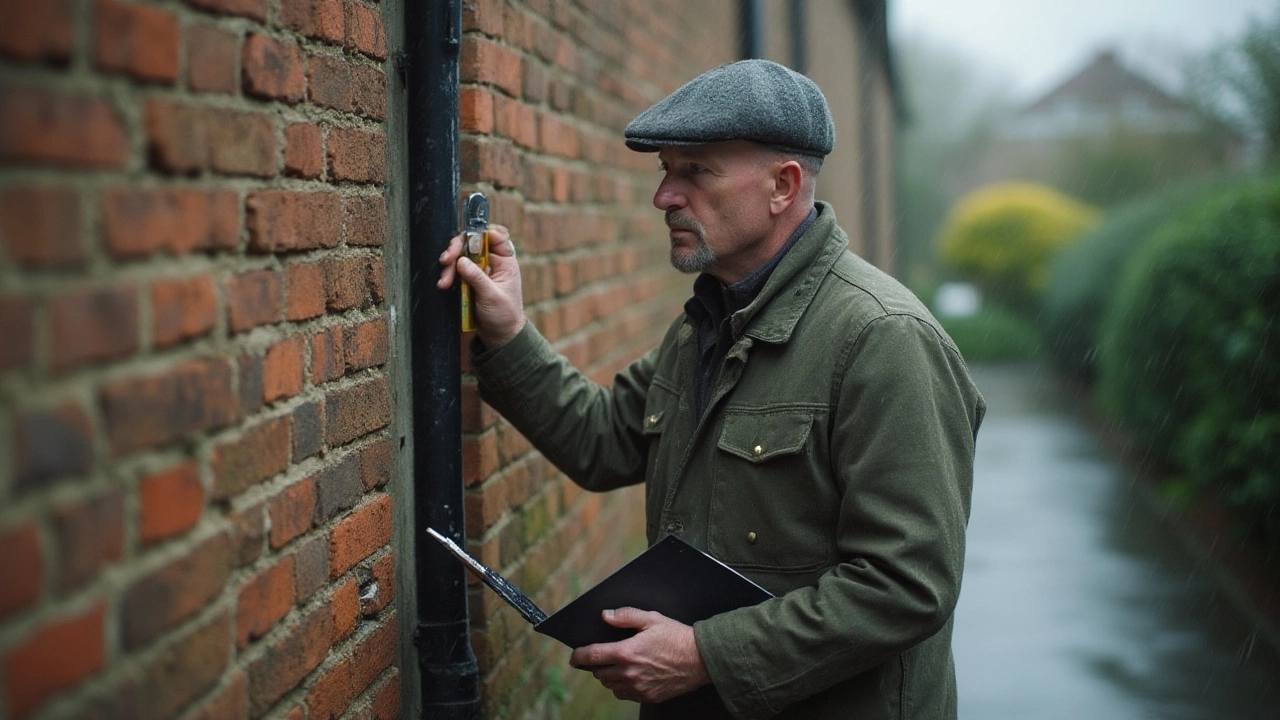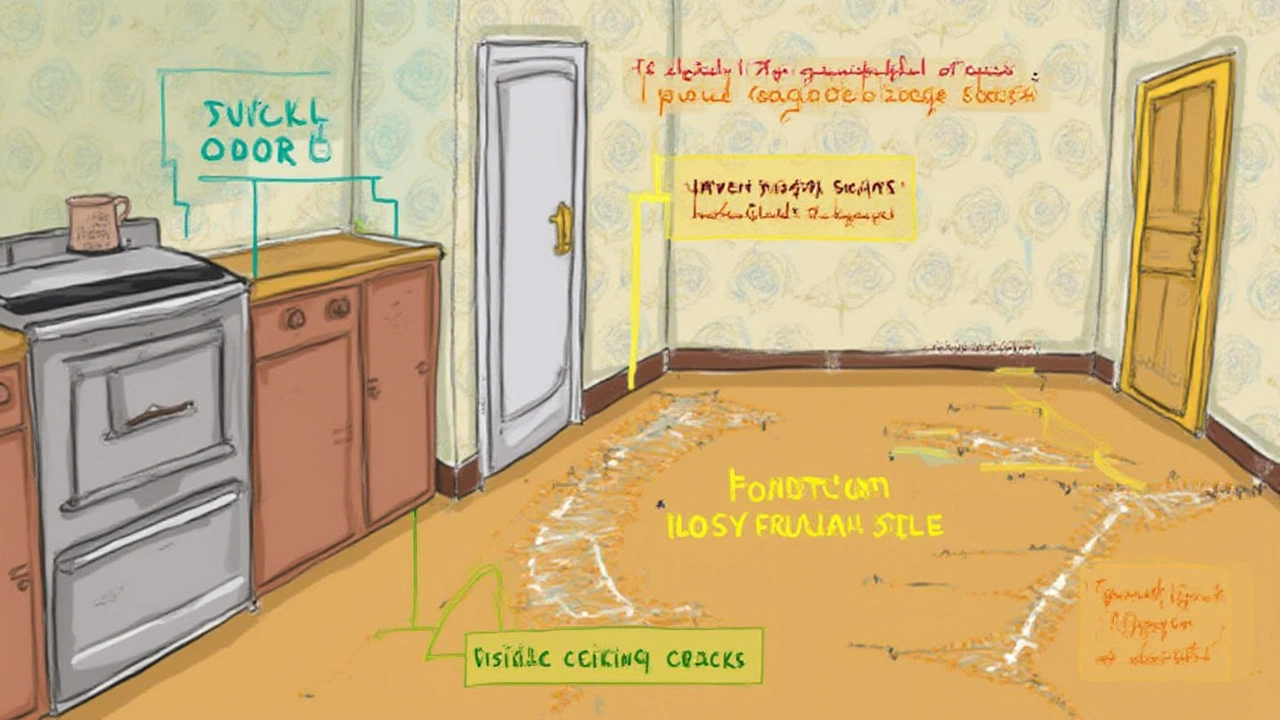Can You Live Safely in a House with a Cracked Foundation? Expert Guide & Real Facts
 Jul, 18 2025
Jul, 18 2025
One minute your basement looks fine; the next, you spot a crack running along the wall or floor. Your heart skips. You wonder, "Am I in danger? Can you actually live safely in a house with a cracked foundation, or is disaster just waiting to happen?" Most folks don’t even notice the signs until they’re obvious—like that sticking door, or the window that suddenly won’t close. Here’s the honest truth: not all foundation cracks are bad news, but some definitely spell trouble. Living in a house with foundation issues isn’t black or white—it’s complicated, with risks and surprises that most homeowners don’t see coming.
Understanding Foundation Cracks: What Do They Mean?
Cracks happen for a bunch of reasons, and the wild thing is, most houses—old or new—have them. A small hairline crack in concrete is almost expected as houses settle, especially in the first few years. Dry seasons cause soil to shrink, heavy rain makes it expand, and temperature shifts don’t help either. According to data from the American Society of Civil Engineers, foundation problems affect around 25% of U.S. homes at some point.
So, should you panic? Absolutely not—but you do need to get savvy about what those cracks are telling you. There are three main types: shrinkage cracks (tiny, usually vertical, and not concerning), settlement cracks (from minor ground shifting or uneven settling), and structural cracks (wider, diagonal or stair-step, or horizontal). The way they run across blocks, slabs, or bricks gives away a lot about the story beneath your floors.
Here’s where things get serious: once a crack is wider than a quarter of an inch, you need to pay attention. If it’s horizontal or forms a staircase pattern in brick or block walls, there might be pressure from outside—heavy soil or even water—that’s pushing hard on your foundation. Tree roots, drought, flood, or even nearby construction can start a chain reaction. Some cracks let in water during storms and invite in mold and pests, which leads to an even bigger headache.
Key facts you probably didn’t know—the most expensive foundation repairs in the U.S. (over $25,000) almost always start as harmless-looking cracks that owners ignored. Moisture is the biggest culprit, with clay-heavy soils in places like Texas and Oklahoma being extra prone to shifting. So next time you notice a crack, know your geography is probably working against you!
| Crack Type | Appearance | Usual Cause | Severity |
|---|---|---|---|
| Shrinkage | Thin, vertical | Concrete drying | Low |
| Settlement | Diagonal/vertical | Soil movement | Medium |
| Structural | Wide, stair-step/horizontal | Wall/basement pressure | High |
Risks of Living with a Cracked Foundation
Plenty of people shrug off cracks, sometimes for years. But a cracked foundation isn’t just ugly; it can get expensive, fast. Safety is the first worry—if you notice doors that stick, slanted floors, or gaps under baseboards, it’s not just about looks. That could mean parts of the house are literally shifting. In rare but real cases, sections of walls or floors can buckle or collapse.
If your house has a basement, cracks are how water gets in. That moisture brings fungus, mold, and pests, which love the dark, damp spaces you never check. Ever wondered why your basement smells musty? Mold, which according to the CDC, triggers allergies and asthma and grows at any sign of ongoing moisture.
Cracks also play havoc with your energy bills. Air sneaks in and out, your HVAC runs overtime, and suddenly that tiny crack is costing you money each month. Termites can wriggle in through gaps as tiny as 1/32 of an inch, and they’re tunnel-producing machines. Once they’re in, they can eat hidden beams, causing tens of thousands in repair bills.
You also can’t ignore insurance ramifications. Most policies don’t cover gradual damage due to settling or soil shifts. The longer you let a crack go, the less likely your claim will be accepted if something serious happens. If you ever plan to sell, buyers (and banks) want clean home inspections. In a 2023 Zillow report, homes with major foundation issues took twice as long to sell and had to discount as much as 20% from their asking price—just because of foundation worries.

Can You Fix Foundation Cracks Yourself?
It’s tempting to slap on a coat of paint or squirt some epoxy into a gap. Plenty of DIY kits promise miracles for $50. But hold up—there’s a fine line between cosmetics and a real fix. For tiny, hairline cracks less than 1/8 of an inch wide and not growing, patching with epoxy or concrete filler can do the trick. Check again after a season or two. If nothing’s changed, you probably dodged a bullet.
But if the crack keeps growing, comes back after patching, or new ones show up, something bigger is moving. That’s a classic red flag. Foundation repair isn’t just about patching from the inside. Sometimes, you need to fix the root problem outside—grading the soil away from your house, fixing gutters, or even installing French drains to reroute water. For anything wider than a pencil, or cracks with water seeping through, skip the DIY and call a pro for an inspection. Engineers use laser levels and meters to measure shifting you can’t see, which changes the whole game for serious repairs.
Fun fact: The most popular foundation repair method in the U.S. is "piering"—installing steel piers deep under the house to lift and stabilize sinking sections. It can cost anywhere from $1,000 to over $20,000, depending on your soil and how bad the cracks have gotten. If that sounds scary, remember—quick action with a cheaper fix (like mudjacking or wall anchors) is often possible if you act early.
Living with a Cracked Foundation: What’s Really at Stake?
Now, nobody wants to hear that their home is slowly coming apart, but the good news is not every crack means panic. Plenty of people live in houses with cracks for years with no problem, especially in older homes with stable, dormant settlement lines. But you do need eyes open and a little caution. Your house is talking—you just have to listen.
For everyday peace of mind, get to know your baseline. Take photos of all cracks, measure their width, and check every few months. If your doors or windows suddenly start acting up, or you spot water stains near a crack, that’s the time to get nosy. Placing a small piece of tape across a crack and writing the date is an old trick used by home inspectors—if the tape splits, you know something’s active.
Controlling water around your house is the single best way to prevent cracks from worsening. Keep gutters clear, make sure downspouts send water at least six feet away from foundations, and adjust landscaping so water slopes away instead of toward your walls. Houses in flood zones or near big trees need special attention—tree roots can easily grow under foundations, and floods bring shifting soils. Some experts suggest annual inspections if you live in high-risk areas or your house is more than 40 years old.
If selling is ever in your future, invest in getting your foundation checked long before you list. An engineer’s written report that says everything is stable is gold during negotiations. Many buyers will want to see recent repair receipts, and many states require sellers to disclose any known foundation issues by law.

When to Worry—and When to Take Action
So, can you live safely in a house with a cracked foundation? For most folks, the short answer is yes—if the cracks are small, not changing, and you’re watching closely. But the danger creeps in when you ignore the warning signs: cracks getting bigger, sticking doors, floors that bounce, new leaks, or a weird slope you never noticed before. If you see these, pause and reconsider your safety.
Here are some specific steps to protect your home and peace of mind:
- Measure and document all visible cracks at least twice yearly.
- Monitor for seasonal changes—cracks can shrink in winter, expand in summer due to soil moisture shifts.
- Check doors and windows for movement—sticky frames often mean walls or sills are shifting.
- Keep basements, crawl spaces, and slabs dry—install sump pumps if water is a problem.
- Learn your soil—if you’re on clay, loam, or fill, you’re at higher risk of movement.
- Never ignore new water stains or musty smells—these often appear before visible leaks or bigger cracks.
- Get professional inspections every 3-5 years, or immediately if you see rapid changes.
- Be proactive with landscaping—avoid big trees near your foundation, and check for roots.
Here’s a quick look at average repair costs you might face, based on national data from HomeAdvisor:
| Repair Type | Average Cost |
|---|---|
| Epoxy Injection (small crack) | $350 - $1,000 |
| Wall Anchors | $2,500 - $5,000 |
| Piering | $1,000 - $3,000 (per pier) |
| Slab Jacking | $500 - $1,300 |
| Major Structural Repairs | $10,000 - $25,000+ |
That’s a big range, but it pays to catch things early. The worst disasters happen when owners turn a blind eye, hoping the cracks will just “work themselves out.” They never do.
If you’re in doubt, get an expert’s eye—the $200 you spend on an engineer’s opinion might save you tens of thousands later. You can absolutely live in a house with a cracked foundation if you know what’s going on and don’t let fear or denial lead to regret. Take charge, watch out for signs, and you’ll sleep a lot easier—without worrying about the floors shifting as you turn out the lights.
